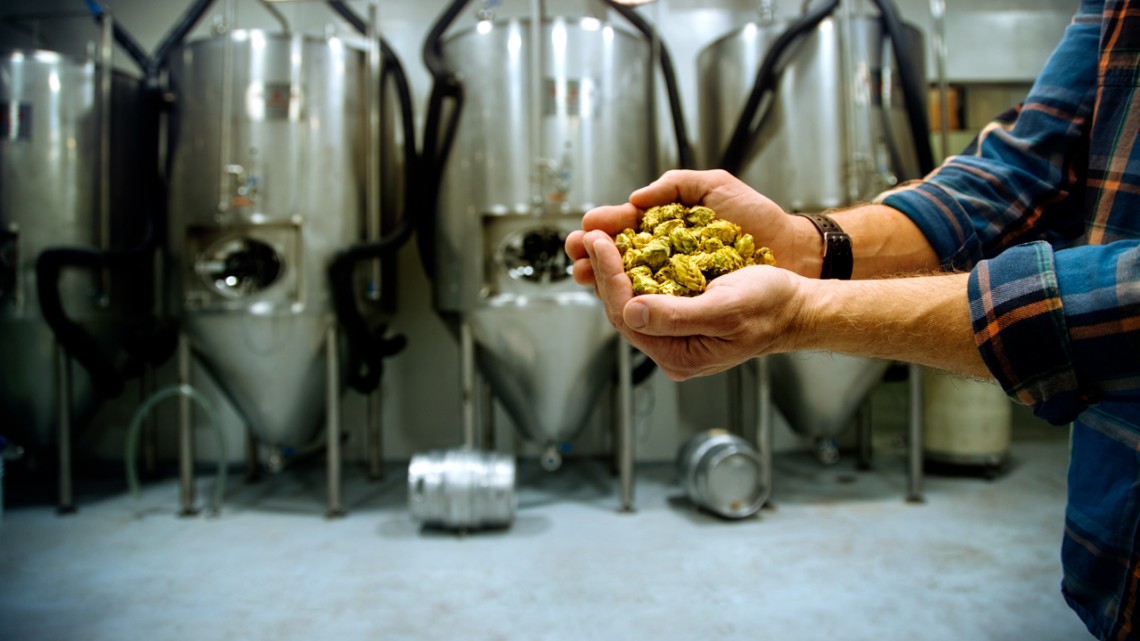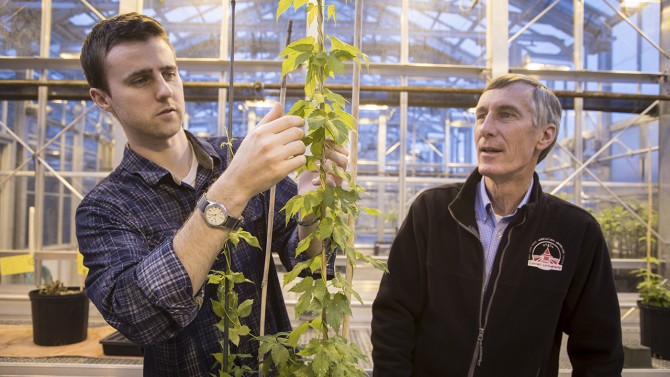
Hops at Liquid State Brewing in Ithaca, N.Y.
Hop growers face challenges to meet rising brewery demands
By Krishna Ramanujan
The New York craft beer industry is really hopping. From 2012 to 2016, the number of breweries more than tripled, from 95 to 302, according to the New York State Brewers Association, and the industry contributes $3.5 billion to the state’s economy annually.
Lawmakers seeking to tap into the industry’s economic potential have passed new policies that provide incentives for New York hop growers to jump on the bandwagon and supply the growing demand for local ingredients. As these growers have learned, cultivating hops has its challenges, mainly from pests and two pervasive diseases, and Cornell researchers are lending a hand.
Plant disease experts David Gadoury and doctoral student Bill Weldon, both at the New York State Agricultural Experiment Station in Geneva, are providing expertise to help everyone from hops hobbyists to professional farmers through outreach materials, public presentations and field visits.
Real-world challenges
Three years ago, J.D. Fowler and a team from Fowler Farms, added 30 acres of hop plants to their 2,000-acre family farm in Wolcott, New York, giving them one of the largest hop yards in the state. Fowler Farms mostly grows apples, but added hops to take advantage of increasing demand from a skyrocketing craft beer industry and recent legislation that stipulates farm breweries must use a percentage of New York-grown hops.
“We thought we’d get in on the front end of it,” Fowler said. As is the case with new opportunities, he wasn’t the only one trying to take advantage of a surge in the local beer industry.
While Fowler grows his hops on a large scale with the same agricultural standards that have kept Fowler Farms in business for six generations, most New York hop growers plant just 1 to 5 acres and started within the last five years. For many growers, inexperience combined with challenges from persistent hop diseases, and such pests as aphids, leaf hoppers, Japanese beetles and two-spotted spider mites have led to inconsistent quality and failed crops.
“Many New York growers lack practical experience with hops,” said Gadoury, a senior research associate in the Plant Pathology and Plant-Microbe Biology Section of the School of Integrative Plant Science in the College of Agriculture and Life Sciences. “It’s kind of like having a depth of knowledge on NASCAR and you’ve gone to a lot of races, but nothing in your experience equips you for getting behind the wheel and driving at 200 miles per hour. It’s a very different thing to read about it compared to doing it.”
In order to get new hop growers up to speed, Gadoury and Weldon have focused on outreach and education. Funded by a one-year, $15,000 Engaged Graduate Student Grant through the Office of Engagement Initiatives, as well as two grants from the United States Department of Agriculture (USDA) Specialty Crops Research Initiative, Weldon traveled to the Pacific Northwest to gain insights from experienced growers; Washington, Oregon and Idaho produce roughly 98 percent of U.S. hops. He also met with New York State growers to better understand their needs.
With this knowledge, he helped produce a new Cornell website that serves as a hub for hops-related information. Growers can find a set of fact sheets on such topics as the five things to consider before planting your first hop plants, and managing downy mildew vs. powdery mildew. A set of videos in development will help with identifications and management strategies.
This past summer, he and Gadoury fielded calls from New York growers, collected pathogen samples, diagnosed diseases and advised growers on management strategies.
Hops history
One hundred years ago, New York was the center for hops production in North America, with an optimal climate for the plant. But the combination of powdery mildew and downy mildew, aphids and alcohol prohibition killed the industry. Hop agriculture moved to the inland Pacific Northwest after that, where a dry climate limits downy mildew, though powdery mildew is a problem.
In 2013, New York lawmakers signed the Farm Brewing Law, designed to bolster New York’s economy by increasing demand for locally grown products and creating new businesses surrounding the brewing industry. The initiative revitalized hop growing in the state.
According to the law, receiving a farm brewery license in New York state requires beer to be made from locally grown farm products. The law is being implemented on a schedule: until the end of 2018, at least 20 percent of all hops, malting barley and all other ingredients must be grown in New York state; from 2019 through 2023, no less than 60 percent of these ingredients must be grown in-state; and from 2024 on, no less than 90 percent must be state-grown.
Overcoming challenges
In spite of high hopes, a resurgence of the hop industry in New York hasn’t been easy. After a hot, dry 2016 summer, Fowler noticed a disease, which turned out to be powdery mildew, on some of the leaves of a hop variety called Zeus. And this year, after a wet summer, some of his crops fell victim to downy mildew.
Gadoury and Weldon visited Fowler’s farm in 2016, took samples and soon after made a diagnosis. They offered Fowler treatment advice, which included spraying safe chemicals and removing infected leaves and diseased plants. For early in the following season, they advised spraying, pruning, training shoots and stripping lower leaves after the first year to reduce humidity.
Tactics for managing downy mildew and powdery mildew differ, particularly when it comes to spraying. Fungicides that are perfect for suppressing downy mildew may not be effective against powdery mildew and vice versa.
“The focus is really on educating growers to choose the right materials for the right disease and then applying them on an as-needed basis,” Gadoury said. “It’s also important to have a knowledge of the basic biology of the organisms that threaten hop plants.”
Fowler has learned that good quality hops come from having a protocol for growing. “Timing is very critical between harvest and processing the hops; there are a lot of steps where the process can go wrong,” he said.
The marketable part of the plant, called the hop cone, grows when the plants start to bloom. This period and the month thereafter present a critical phase for managing disease. “The hop flower, which ends up being the cone, consists of rapidly growing tissues that are more susceptible to infection; it's a time when pathogens can take advantage of that young new tissue,” Weldon said.
Fowler said he has found that certain varieties are more susceptible to mildews. He has five varieties that make up the bulk of his hop yard, but this year added five more test varieties of interest to brewers.
According to brewers, the quality of New York-grown hops has been inconsistent so far. Many brewers source their local hops from hobbyists, who are still learning. Also, brewers want certain varieties, such as Cascade for IPAs, but some of those varieties may be more susceptible to disease and pests. As a consequence, many New York brewers have no choice but to source some of their hops from Washington and Oregon, and that's a lost opportunity for New York hop growers.
“That’s one of the things we are trying to change, having high-quality varieties and enough of them,” Fowler said.
Getting the word out to growers on how to grow healthy, high quality hops is a top priority of the Cornell and USDA projects. Weldon is scheduled to make presentations at the Annual Cornell Hops Conference at Morrisville State College in Morrisville, New York, in early December, and at the USA Hops annual meeting in Palm Desert, California, later this winter.
Media Contact
Get Cornell news delivered right to your inbox.
Subscribe




